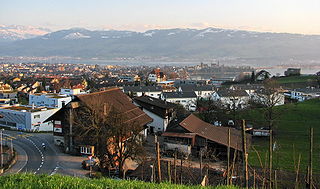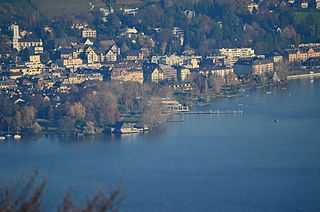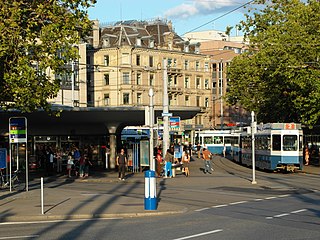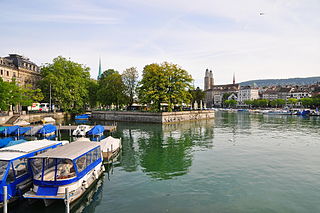
Lake Zurich is a lake in Switzerland, extending southeast of the city of Zürich. Depending on the context, Lake Zurich or Zürichsee can be used to describe the lake as a whole, or just that part of the lake downstream of the Seedamm at Rapperswil, whilst the part upstream of Rapperswil may be called the Obersee or Upper Lake.

The canton of Zürich is a Swiss canton in the northeastern part of the country. With a population of 1,553,423, it is the most populous canton in the country. Zürich is the de facto capital of the canton, but is not specifically mentioned in the constitution. The official language is German. The local Swiss German dialect, called Züritüütsch, is commonly spoken.

Rapperswil-Jona is a municipality in the Wahlkreis (constituency) of See-Gaster in the canton of St. Gallen in Switzerland. Besides Rapperswil and Jona, which were separate municipalities until 2006, Rapperswil-Jona also includes Bollingen, Busskirch, Curtiberg, Kempraten-Lenggis, Wagen, and Wurmsbach.

Enge is a quarter in District 2 of Zürich, Switzerland.

The Zürichsee-Schifffahrtsgesellschaft or Lake Zürich Navigation Company is a public Swiss company operating passenger ships and boats on Lake Zürich.

Rapperswil is a former municipality and since January 2007 part of the municipality of Rapperswil-Jona in the Wahlkreis (constituency) of See-Gaster in the canton of St. Gallen in Switzerland, located between Obersee and the main part of Lake Zurich.

The Limmat Valley is a river valley and a region in the cantons of Zürich and Aargau in Switzerland.

Feldmeilen is a village (Wacht) within the municipality of Meilen in the Canton of Zürich in Switzerland.

Zürichhorn is a river delta on Zürichsee's eastern shore in the lower basin of the lake. The area is part of the parks and quays in the Seefeld quarter of the city of Zürich in Switzerland. The gardens are one of the most popular recreational areas within the city of Zürich.

Hurden is a village in the municipality of Freienbach in the canton of Schwyz in Switzerland. First mentioned in 1217, the name "de Hurden" was used for the peninsula and for the fish traps made of woven work, called "Hürden" or "Hurden", which were used by the locals.

Turicum was a Gallo-Roman settlement at the lower end of Lake Zurich, and precursor of the city of Zürich. It was situated within the Roman province of Gallia Belgica and near the border to the province of Raetia; there was a tax-collecting point for goods traffic on the waterway Walensee–Obersee-Zürichsee–Limmat–Aare–Rhine.

Kleiner Hafner is one of the 111 serial sites of the UNESCO World Heritage Site Prehistoric pile dwellings around the Alps, of which are 56 located in Switzerland.

Grossner Hafner is one of the 111 serial sites of the UNESCO World Heritage Site Prehistoric pile dwellings around the Alps, of which are 56 located in Switzerland.

Prehistoric pile dwellings around Lake Zurich comprises 11 – or 10% of all European pile dwelling sites – of a total of 56 prehistoric pile dwellings around the Alps in Switzerland, that are located around Lake Zurich in the cantons of Schwyz, St. Gallen and Zürich.

Rapperswil-Jona–Technikum is one of the 111 serial sites of the UNESCO World Heritage Site Prehistoric pile dwellings around the Alps, of which are 56 located in Switzerland. Located on a small former island on upper Lake Zürich in Rapperswil, a locality of the municipality of Rapperswil-Jona in the Canton of St. Gallen. Due to its location on a former island at the medieval Heilig Hüsli bridge chapel, the site sometimes is also referred to Rapperswil Heilighüsli or Inseldorf, meaning island village.

Zürich–Enge Alpenquai is one of the 111 serial sites of the UNESCO World Heritage Site Prehistoric pile dwellings around the Alps, of which 56 are located in Switzerland.

Bellevueplatz is a town square in Zürich, Switzerland built in 1856. Named after the former Grandhotel Bellevue on its north side, it is one of the nodal points for roads and public transportation in Zürich, as well as an extension of the quaysides in Zürich that were built between 1881 and 1887.

Bürkliplatz is a town square in Zürich, Switzerland. It is named after Arnold Bürkli, and is one of nodal points of the road and public transportation, and of the lake shore promenades that were built between 1881 and 1887. The tree-shaded square between Bahnhofstrasse and Fraumünsterstrasse is called Stadthausanlage.

Bauschänzli is an artificial island, town square, and public park in Zürich, Switzerland. Bauschänzli is one of the last remains of the Baroque fortifications of Zürich which began in 1642. The neighboring Schanzengraben (moat) and the Old Botanical Garden are part of these remains. Since 1907, the island has been used as a restaurant, although it is officially a public square and park.


























